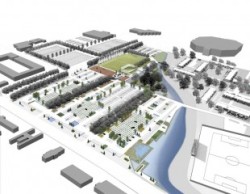Feb 22 2010
As engineers and energy companies develop plans for alternative energy production that will allow humans to continue to pursue otherwise unsustainable consumption patterns, Steve Luoni attacks the problem of limited resources from a radically different angle. Emphasizing the city as ecology, or ecosystem, Luoni and his colleagues in the University of Arkansas Community Design Center lead the movement toward intelligent design of urban landscapes that will reduce energy consumption and limit man’s impact on the environment.
 As engineers and energy companies develop plans for alternative energy production that will allow humans to continue to pursue otherwise unsustainable consumption patterns, Steve Luoni attacks the problem of limited resources from a radically different angle
As engineers and energy companies develop plans for alternative energy production that will allow humans to continue to pursue otherwise unsustainable consumption patterns, Steve Luoni attacks the problem of limited resources from a radically different angle
Luoni, professor of architecture and director of the center, will present the main principles of this movement at 3:30 p.m. Sunday, Feb. 21, at the American Association for the Advancement of Science annual meeting in San Diego. He will participate in the panel Urban Design and Energy Demand: Transforming Cities for an Eco-Energy Future.
Luoni focuses on six design models that demonstrate the essentials of what he calls recombinant ecologies, which are urban centers and landscapes that feature:
- Watershed urbanism, or a “re-wilding” of rivers and creeks
- Context-sensitive highway design
- Green and shared streets
- Transit-oriented development
- Urban forestry and, perhaps most importantly
- Low-impact development
“Recombinant ecologies offer new forms of energy management requiring less fossil fuels by recombining social and environmental measures into economic development,” Luoni says. “They solve problems through biological and urban patterns simultaneously. Their design promotes self-organization, emergence, resilience and productive forms of feedback between environment and the city. Done properly, recombinant ecologies manage natural capital in the delivery of environmental and urban services.”
Exactly how does one solve modern urban problems – nonpoint-source pollution, poor flood control and water quality, erosion and climate disturbance, for example – through biological patterns? In Campus Hydroscapes, a 2,000-foot watershed regeneration project for College Branch on the University of Arkansas campus, Luoni and his colleagues propose restoring ecological functions to an urban stream that cuts through the university’s athletic complex.
While massive structures, such as the university’s football stadium and basketball arena, cannot be moved, the design team proposes “re-wilding” exposed sections of the creek by re-introducing native trees and plants to stabilize creek banks. They also will incorporate nature’s riffle-glide-pool channel design to better control erosion and restore the broader flood plain, including parking areas with permeable surfaces, to mitigate flooding and allow nature to treat pollutants and other chemicals on site. The plan also includes a park and recreational areas along the riparian corridor.
The concept for Campus Hydroscapes exemplifies what urban designers and ecologists call watershed urbanism. Based on ecological science, watershed urbanism proposes restoring ecological functions, such as erosion control, waste treatment and carbon sequestration, in riparian areas while forming urban networks of linear parks, neighborhood open spaces and pedestrian facilities.
With assistance from the Environmental Protection Agency, ecological engineering professor Marty Matlock and McClelland Consulting Engineers Inc., a local firm, Luoni’s team is also working on Porchscapes, a 43-unit, affordable neighborhood development on an 8-acre site in southeast Fayetteville. The project is an example of low-impact development, a type of residential or commercial development in which the design of streets and storm-water systems are modeled after nature to manage rainfall locally through a vegetated treatment network that keeps water on site.
In contrast to conventional infrastructure that simply transports runoff to a single point through pipes, catchment basins, curbs and gutters and thus offers no ecological services beyond detention and storage, low-impact development sustains a site’s predevelopment, hydrologic state by using techniques that infiltrate, filter, store and evaporate storm-water runoff. This is accomplished through a contiguous network of sediment filters, tree box filters, rainwater gardens, bioswales, infiltration basins and wet meadows.
In Visioning Rail Transit in Northwest Arkansas: Lifestyles and Ecologies, the center’s study advocating political and grassroots support for construction of a light rail system, Luoni argues that northwest Arkansas could be a national model of smart growth if the region would progressively shape its expansion based on transit-oriented development rather than chasing expansion retroactively by building streets to reach new developments on the margins of its various communities. Luoni emphasizes that the geographical location and growth patterns of the region’s cities are ideal for light-rail transit.
He isn’t the first planner to emphasize that only fixed guide-way systems, such as subways and light rail, prompt developers to build walkable, mixed-use neighborhoods. Such systems optimize a region’s transportation efficiency, generate downtown revitalization, decrease land and energy consumption and facilitate neighborhood-based commerce beyond the suburban big box retail center.
“A transportation system that includes rail provides more transit options,” Luoni says. “It increases access for transit-challenged populations while reducing congestion and individual transportation costs.”
Light rail systems concentrate populations, which relieves the stress of being forced to come up with more or different energy sources, Luoni says. These systems function most efficiently as peak-demand transportation systems. Automobiles and buses, as transportation modes, distribute populations and do not create economic and social benefits.
“Viewing and designing the city as an ecosystem will facilitate lower energy and land consumption through novel solutions that leverage social creativity and a sense of place,” says Luoni, who holds the Steven L. Anderson Chair in Architecture and Urban Studies.
Source: http://www.uark.edu/home/